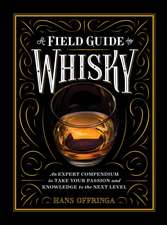Handbook of Natural Antimicrobials for Food Safety and Quality: Woodhead Publishing Series in Food Science, Technology and Nutrition
Editat de M. Tayloren Limba Engleză Paperback – 18 aug 2016
- Reviews different types of antimicrobials used in food safety and quality
- Covers how antimicrobials are created to be used in different foods
- Examines how the antimicrobials are used in foods to enhance the safety and quality
Din seria Woodhead Publishing Series in Food Science, Technology and Nutrition
- 15%
 Preț: 391.19 lei
Preț: 391.19 lei - 24%
 Preț: 1210.03 lei
Preț: 1210.03 lei - 24%
 Preț: 946.43 lei
Preț: 946.43 lei - 24%
 Preț: 960.56 lei
Preț: 960.56 lei - 23%
 Preț: 1419.50 lei
Preț: 1419.50 lei - 9%
 Preț: 1205.99 lei
Preț: 1205.99 lei - 24%
 Preț: 1189.10 lei
Preț: 1189.10 lei - 9%
 Preț: 1006.66 lei
Preț: 1006.66 lei - 9%
 Preț: 984.09 lei
Preț: 984.09 lei - 9%
 Preț: 1206.85 lei
Preț: 1206.85 lei - 24%
 Preț: 1081.43 lei
Preț: 1081.43 lei - 24%
 Preț: 1185.22 lei
Preț: 1185.22 lei - 9%
 Preț: 922.07 lei
Preț: 922.07 lei - 24%
 Preț: 1192.22 lei
Preț: 1192.22 lei - 9%
 Preț: 1215.75 lei
Preț: 1215.75 lei - 24%
 Preț: 1162.37 lei
Preț: 1162.37 lei - 9%
 Preț: 950.09 lei
Preț: 950.09 lei - 24%
 Preț: 1162.62 lei
Preț: 1162.62 lei - 24%
 Preț: 801.31 lei
Preț: 801.31 lei - 27%
 Preț: 379.84 lei
Preț: 379.84 lei - 29%
 Preț: 1336.07 lei
Preț: 1336.07 lei - 24%
 Preț: 798.74 lei
Preț: 798.74 lei - 24%
 Preț: 1333.02 lei
Preț: 1333.02 lei - 9%
 Preț: 1018.93 lei
Preț: 1018.93 lei - 31%
 Preț: 922.77 lei
Preț: 922.77 lei - 9%
 Preț: 1045.58 lei
Preț: 1045.58 lei - 24%
 Preț: 1131.77 lei
Preț: 1131.77 lei - 23%
 Preț: 1635.83 lei
Preț: 1635.83 lei - 9%
 Preț: 1277.62 lei
Preț: 1277.62 lei - 24%
 Preț: 1049.04 lei
Preț: 1049.04 lei - 24%
 Preț: 1134.60 lei
Preț: 1134.60 lei - 9%
 Preț: 1076.36 lei
Preț: 1076.36 lei - 24%
 Preț: 1158.21 lei
Preț: 1158.21 lei - 9%
 Preț: 1065.06 lei
Preț: 1065.06 lei - 9%
 Preț: 1067.39 lei
Preț: 1067.39 lei - 24%
 Preț: 812.03 lei
Preț: 812.03 lei - 9%
 Preț: 1203.13 lei
Preț: 1203.13 lei - 23%
 Preț: 1237.19 lei
Preț: 1237.19 lei - 24%
 Preț: 948.79 lei
Preț: 948.79 lei - 23%
 Preț: 1138.06 lei
Preț: 1138.06 lei - 9%
 Preț: 868.43 lei
Preț: 868.43 lei - 24%
 Preț: 871.98 lei
Preț: 871.98 lei - 20%
 Preț: 1272.59 lei
Preț: 1272.59 lei - 29%
 Preț: 1195.06 lei
Preț: 1195.06 lei - 9%
 Preț: 1002.45 lei
Preț: 1002.45 lei - 9%
 Preț: 505.72 lei
Preț: 505.72 lei - 9%
 Preț: 1062.13 lei
Preț: 1062.13 lei - 24%
 Preț: 1306.94 lei
Preț: 1306.94 lei
Preț: 1272.06 lei
Preț vechi: 2083.69 lei
-39% Nou
Puncte Express: 1908
Preț estimativ în valută:
243.40€ • 254.82$ • 201.40£
243.40€ • 254.82$ • 201.40£
Carte tipărită la comandă
Livrare economică 29 martie-12 aprilie
Preluare comenzi: 021 569.72.76
Specificații
ISBN-13: 9780081013991
ISBN-10: 008101399X
Pagini: 442
Dimensiuni: 152 x 229 x 23 mm
Greutate: 0.59 kg
Editura: ELSEVIER SCIENCE
Seria Woodhead Publishing Series in Food Science, Technology and Nutrition
ISBN-10: 008101399X
Pagini: 442
Dimensiuni: 152 x 229 x 23 mm
Greutate: 0.59 kg
Editura: ELSEVIER SCIENCE
Seria Woodhead Publishing Series in Food Science, Technology and Nutrition
Cuprins
- Related titles
- List of contributors
- Woodhead Publishing Series in Food Science, Technology and Nutrition
- Preface
- 1. The use of natural antimicrobials in food: an overview
- 1.1. Introduction
- 1.2. Types of natural antimicrobials: animal sources
- 1.3. Types of natural antimicrobials: plant sources
- 1.4. Types of natural antimicrobials: microbial sources
- 1.5. Challenges to application of natural antimicrobials to foods
- 1.6. Application of natural antimicrobials
- 1.7. Conclusions
- Part One. Types
- 2. Plant extracts as antimicrobials in food products: types
- 2.1. Introduction
- 2.2. Herbs, spices, and plant extracts as antimicrobials
- 2.3. Essential oils
- 2.4. Plant extracts in combination with minerals
- 2.5. Conclusion
- 3. Plant extracts as antimicrobials in food products: mechanisms of action, extraction methods, and applications
- 3.1. Introduction
- 3.2. Mechanisms of action of plant extracts
- 3.3. Plant extracts and antibiotic resistance
- 3.4. Extraction methods to maximize antimicrobial properties
- 3.5. Response of Gram-positive and Gram-negative bacteria to plant extracts
- 3.6. Applications of plant extracts in food products
- 3.7. Conclusion
- 4. Bacteriophages as antimicrobials in food products: history, biology and application
- 4.1. Introduction
- 4.2. Research into bacteriophages
- 4.3. Biology of bacteriophages
- 4.4. Bacteriophages as biocontrol agents in food
- 4.5. The use of phage endolysins as biocontrol agents in food
- 4.6. Combining bacteriophages with other preservation techniques to enhance food safety
- 5. Bacteriophages as antimicrobials in food products: applications against particular pathogens
- 5.1. Introduction
- 5.2. Bacteriophages to control Gram-negative food-borne pathogens
- 5.3. Bacteriophages to control Gram-positive food-borne pathogens
- 5.4. Conclusion and future trends
- 6. Lactic acid bacteria (LAB) as antimicrobials in food products: types and mechanisms of action
- 6.1. Introduction
- 6.2. Characteristics of lactic acid bacteria (LAB)
- 6.3. Carbohydrate metabolism in LAB
- 6.4. Effects of culture preparation and storage techniques on LAB
- 6.5. Antimicrobial compounds produced by LAB: organic acids, diacetyl, and hydrogen peroxide
- 6.6. Antimicrobial compounds produced by LAB: bacteriocins
- 6.7. Conclusions
- 7. Lactic acid bacteria (LAB) as antimicrobials in food products: analytical methods and applications
- 7.1. Introduction
- 7.2. Screening lactic acid bacteria (LAB) for antimicrobial activity
- 7.3. Regulatory framework governing the use of LAB in food
- 7.4. Methods for using LAB as biopreservatives in food
- 7.5. Use of LAB in the biopreservation of particular food products and as a biosanitizer
- 7.6. Conclusions
- 8. Chitosan as an antimicrobial in food products
- 8.1. Introduction
- 8.2. Overview of antimicrobial activity of chitosan
- 8.3. Mechanism of action
- 8.4. Effects of molecular structure
- 8.5. Effects of environmental conditions
- 8.6. Current applications and future trends
- 2. Plant extracts as antimicrobials in food products: types
- Part Two. Processing
- 9. Evaluating natural antimicrobials for use in food products
- 9.1. Introduction
- 9.2. The advantages of using antimicrobials in food preservation
- 9.3. The use of natural antimicrobials in food preservation
- 9.4. Combining antimicrobials with other preservation techniques
- 9.5. Factors affecting the biocidal activity of natural antimicrobials
- 9.6. The regulation of natural antimicrobials
- 9.7. Conclusion
- 10. Physical and chemical methods for food preservation using natural antimicrobials
- 10.1. Introduction
- 10.2. Physical application of natural antimicrobials
- 10.3. Chemical application of natural antimicrobials
- 10.4. Biological application of natural antimicrobials
- 10.5. Commercial natural antimicrobials
- 10.6. Conclusion and future trends
- 11. Nanostructured and nanoencapsulated natural antimicrobials for use in food products
- 11.1. Introduction
- 11.2. Natural food antimicrobials
- 11.3. Nanostructures for antimicrobial delivery
- 11.4. Methods for characterization of nanostructures
- 11.5. Food applications of nanostructured antimicrobial systems
- 11.6. Conclusions and future trends
- 12. Modelling the effects of natural antimicrobials as food preservatives
- 12.1. Introduction
- 12.2. Antimicrobial susceptibility assessment
- 12.3. Mathematical modelling in food preservation
- 12.4. Types of models
- 12.5. Model development
- 12.6. Modelling the effects of natural antimicrobial agents
- 12.7. Conclusion and future trends
- 9. Evaluating natural antimicrobials for use in food products
- Part Three. Using natural antimicrobials in particularfoods
- 13. Using natural antimicrobials to enhance the safety and quality of fresh and processed fruits and vegetables: types of antimicrobials
- 13.1. Introduction
- 13.2. Fresh and processed fruits and vegetables: advances and challenges
- 13.3. Natural antimicrobials used in assuring the safety and quality of fresh and processed fruits and vegetables: antimicrobials from plant essential oils
- 13.4. Antimicrobials from plants: aldehydes and methyl jasmonate
- 13.5. Antimicrobials from plants: phenolic compounds and isothiocyanates
- 13.6. Chitosan is not from plant origin
- 13.7. Natural antimicrobials of microbial origin: lactic acid bacteria (LAB) and bacteriocins
- 13.8. Conclusion and future trends
- 14. Using natural antimicrobials to enhance the safety and quality of fresh and processed fruits and vegetables: application techniques and quality issues
- 14.1. Introduction
- 14.2. Techniques for applying natural antimicrobials to fruits and vegetables: key issues
- 14.3. Encapsulation of natural antimicrobials
- 14.4. Edible films and coatings enriched with natural antimicrobials
- 14.5. Antioxidant properties of natural antimicrobials
- 14.6. Plant antimicrobials as flavoring compounds
- 14.7. Conclusion and future trends
- 15. Using natural antimicrobials to enhance the safety and quality of milk
- 15.1. Introduction
- 15.2. Enhancing the safety and quality of milk-based beverages using natural antimicrobials: milk
- 15.3. Enhancing the safety and quality of infant milk formulas using natural antimicrobials
- 15.4. Enhancing the safety and quality of egg–milk beverages using natural antimicrobials
- 15.5. Conclusion and future trends
- 16. Using natural antimicrobials to enhance the safety and quality of fruit- and vegetable-based beverages
- 16.1. Introduction
- 16.2. Enhancing the safety and quality of fruit- and vegetable-based beverages using natural antimicrobials
- 16.3. Melon and watermelon juices
- 16.4. Orange and orange-based juices
- 16.5. Grape juices
- 16.6. Apple and pear juices
- 16.7. Dark fruit juices
- 16.8. Tomato juices
- 16.9. Other vegetable beverages
- 16.10. Conclusion and future trends
- 17. Using natural antimicrobials to enhance the safety and quality of alcoholic and other beverages
- 17.1. Introduction
- 17.2. Alcoholic beverages
- 17.3. Wine
- 17.4. Beer
- 17.5. Apple cider
- 17.6. Hot drinks
- 17.7. Conclusion and future trends
- 18. Using natural antimicrobials to enhance the safety and quality of poultry
- 18.1. Introduction
- 18.2. Food safety and its role in food quality
- 18.3. Pre-harvest use of natural antimicrobials
- 18.4. Antimicrobials for use on poultry products
- 18.5. Conclusion and future trends
- 13. Using natural antimicrobials to enhance the safety and quality of fresh and processed fruits and vegetables: types of antimicrobials
- Index
Recenzii
"...focuses on new developments to enhance the quality, safety, applications, and effectiveness of natural antimicrobials in food." --IFIS




